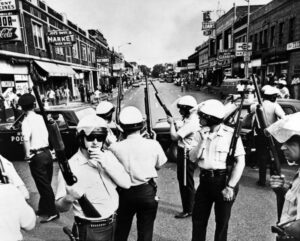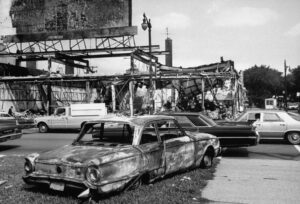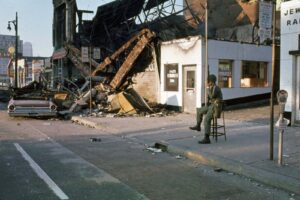
 There have been times in the history of our nation, when peace seemed to reign in the land, and then there have been times, when chaos was the word of the day. in 1967, chaos was definitely the word of the day…in Detroit, Michigan, anyway. In 1967, Detroit was a city that was struggling economically, and racially. During that time, vice squad raids, looking for illegal drinking establishments in the city’s poorer neighborhoods were common, and people were in a state of high irritation.
There have been times in the history of our nation, when peace seemed to reign in the land, and then there have been times, when chaos was the word of the day. in 1967, chaos was definitely the word of the day…in Detroit, Michigan, anyway. In 1967, Detroit was a city that was struggling economically, and racially. During that time, vice squad raids, looking for illegal drinking establishments in the city’s poorer neighborhoods were common, and people were in a state of high irritation.
During one particular raid that occurred at 3:35am on Sunday morning, July 23, 1967, the Detroit Police Department moved in against a club that was hosting a party for returning Vietnam War veterans. The early-morning police activity angered a crowd of onlookers, and before long, the situation became explosive. Before long, thousands of people had rushed out onto the street from nearby buildings. The crown began throwing rocks and bottles at the police, who quickly fled the scene. Getting rid of the police, however, didn’t resolve the situation. The crowd began looting on 12th Street, where the club was located, and a number of shops and businesses were completely trashed!!
By sunrise, fires began breaking out and before long, the whole street was on fire. By midmorning, the police were finally called back to the scene, but controlling the crowd proved to be a major struggle. Unfortunately, getting the situation under control proved to be much more difficult than getting it started. The rioting continued all week, in the end, the US Army and the National Guard were called in to stop the worst of it. Five days later, when the bloodshed, burning, and looting ended, 43 people were dead and many more were seriously injured. In all, approximately 1,400 buildings had been burned or ransacked.
Crowds can quickly get out of control, but sometimes the fault lies equally between crowds and police. In this case, the Detroit Police Department was run directly by the mayor, and prior to the riot, Mayor Cavanagh’s appointees, George Edwards and Ray Girardin, worked for reform. Edwards even tried to recruit and promote black police officers in an effort to help quell racial tensions, but in what might be his biggest mistake, he refused to establish a civilian police review board, which the African American population had requested. He was trying to discipline police officers accused of brutality, and in doing so, he turned the police department’s rank-and-file against him. Many whites perceived his policies as “too soft on crime.” The Community Relations Division of the Michigan Civil Rights Commission, in a study in 1965 of the police, which was published in 1968, claimed the “police system” was at fault for racism. They blamed the police system was blamed for recruiting “bigots” and reinforcing bigotry through the department’s “value system.” President Johnson’s Kerner 
 Commission conducted a survey that found that prior to the riot, 45 percent of police working in black neighborhoods were “extremely anti-Negro” and an additional 34 percent were “prejudiced.” I suppose some might say that the fault of the riot was the police, but to a degree, they were doing their jobs too. Maybe it was the way the did it, and the fact that they ran when it got out of hand. Whatever the case may be, the outcome was horrific.
Commission conducted a survey that found that prior to the riot, 45 percent of police working in black neighborhoods were “extremely anti-Negro” and an additional 34 percent were “prejudiced.” I suppose some might say that the fault of the riot was the police, but to a degree, they were doing their jobs too. Maybe it was the way the did it, and the fact that they ran when it got out of hand. Whatever the case may be, the outcome was horrific.


One Response to Racial Unrest